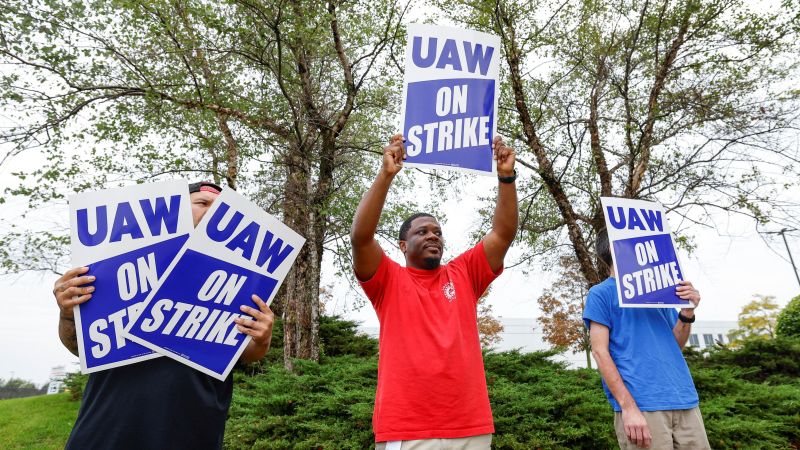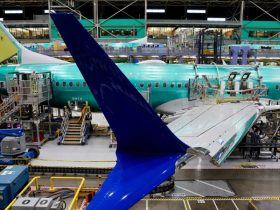The United Auto Workers union has reached a tentative agreement with Stellantis, which makes vehicles under the Dodge, Ram, Chrysler and Jeep brands, a source familiar with the negotiations told CNN.
Although union negotiators and the automaker have a deal, it still needs to be presented to and signed off by union leadership before it is announced. That could happen later Saturday.
The tentative agreement with Stellantis Saturday follows a similar deal reached with Ford Wednesday. Neither is official, as they both need to be ratified by a vote of rank-and-file UAW members at the companies before they will take effect.
The terms of the agreement with Stellantis were not yet known. Both Stellantis and the union declined to comment.
The source also said that negotiators are close to a tentative agreement with General Motors. The union and GM declined to comment on the status of their negotiations. A spokesperson for GM said only that negotiations are continuing.
Ford’s deal gives union workers sizeable pay and benefits increases to contend with inflation that has taken a bite out of workers paychecks. The last contract was reached in 2019, before runaway price hikes began in the wake of the pandemic.
The automakers typically offer union members similar deals across companies, so the Stellantis and GM negotiations are expected to yield similar benefits for the autoworkers.
If the agreements are reached, it would likely put an end to the longest autoworkers strike in 25 years.
The Ford deal will give members an immediate 11% raise upon ratification, and additional increases that will provide workers a total of 25 percentage points of pay hikes by the time the contract expires in early 2028. In addition, workers will have a return of cost-of-living adjustments made to their hourly pay rate to protect them against price increases.
When the cost-of-living adjustments and guaranteed raises are combined, they are expected to raise Ford workers’ wages 30% or more. There will be even bigger pay increases for workers now in a lower pay tier, for temporary workers and for starting pay.
The union has also won improved pension benefits for senior workers who have a traditional pension plan, and increased company contributions to 401 (k) accounts of workers hired since 2007. But the union did not get its goal of a resumption of traditional pension plans for those post-2007 hires, or for a return of retiree health care coverage.
The ratification process at Ford is due to start Sunday with a meeting in Detroit of local union officials who represent Ford workers around the country. While the deal includes record gains for the union, with double-digit pay increases, ratification is not certain.
Generally a union will not have strikers return to work until a tentative labor agreement has been ratified. But the UAW had workers return to work at Ford while the ratification process is underway. That stepped up pressure on GM and Stellantis to quickly reach their own deals with the union.
“The last thing they want is for Ford to get back to full capacity while they mess around and lag behind,” said UAW Vice President Chuck Browning, the union’s chief negotiator at Ford, in comments to members Wednesday night.
Some members have already returned to work at Ford as the company prepares to resume operations, said Todd Dunn, UAW Local 862 president, who represents workers at Kentucky Truck Plant, Ford’s largest factory. Others are due back on Saturday. The plan is that by Monday, the plant will be running at full capacity, he said.
The union has been on strike since September 15 against GM, Stellantis and Ford, the first time the union has ever struck all three companies at once. The union represents 145,000 workers between the three companies, but it did not have all of its members go on strike.
Instead, it has been conducting targeted strikes at specific plants. It began with 12,700 members walking out at one assembly plant at each company, and it has expanded the scope of the strike five times since then. At the time the Ford deal was announced, there were 16,600 members on strike at Ford, 14,200 on strike at GM and 14,600 on strike at Stellantis.
Most recently the union had 6,800 members walk out at the Stellantis plant in Sterling Heights, Michigan, on Monday, and 5,000 members go on strike at the largest GM plant in Arlington, Texas, on Tuesday, shortly after GM reported stronger than expected quarterly earnings.
In its earnings report, GM reported that it lost $200 million over the first two weeks of the strike in late September, and it lost another $600 million in the first three weeks of October. But the closing of the Arlington plant alone is likely to cause losses of an additional $130 million a week, according to an estimate from Colin Langan, an auto analyst with Wells Fargo.
Stellantis has not given a loss estimate from the strike, but Langan estimates the Sterling Heights plant being on strike raises its weekly losses by $110 million a week to $200 million.
Read the full article here













Leave a Reply